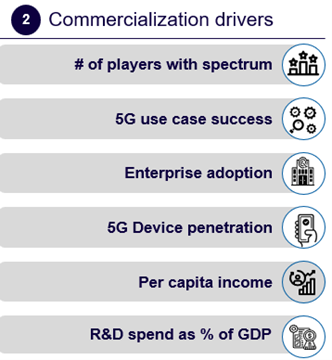By Vandhna Babu
5G adoption in India is dependent on a variety of drivers including infrastructure and commercialization ones. Last year, the spectrum auctions happened and huge investments have also been undertaken across the telecom infrastructure ecosystem, with the telcos spending over USD 20 bn on 5G spectrum.
Some of the infrastructure drivers include –

- 5G Spectrum availability – The telcos spent over INR 1.5 lakh cr. (~USD 20 Bn) in acquiring the 5G spectrum. Though the allocation process is complete, existing spectrum will also be used for 5G.
- Government support – The government launched programs like BharatNet and has been developing other policies on infrastructure sharing and street furniture usage, which will enable smoother network service from telecoms.
- Fibre and E-band coverage – Fibre penetration and E-band deployment allowance are positive enablers for 5G and essential to realize the low latency and high-speed promises.
- In-building solutions – Enhancing telecom connectivity solutions inside the buildings become critical to provide the required network availability with 5G.
- Tower Density – The tower density at present in the country is sub-optimal to provide reasonable 5G service. The number of towers need to increase by a factor of 1.75x to meet the 5G demand.
- In-Building Solutions – Spectrum auction, network densification and fiberization are CAPEX intensive demands. Govt initiatives and investments are expected to ease this pressure.
Success of 5G is dependent on enterprise penetration, individual consumer adoption and use case development. Some of the commercialization drivers include –

- Number of players with spectrum – Apart from the key telecom players, other conglomerates also participated in the auctions for 5G spectrum, thus witnessing unprecedented participation.
- 5G use case success – 5G adoption is dependent on the use case evolution, with ecosystem players collaborating and conducting trials for the same and witnessing successful results.
- Enterprise adoption – Enterprise use case adoption is expected to be a major revenue generator in 5G for telecoms. Private networks and edge computing are major drivers for this increased adoption.
- 5G device penetration – Affordable 5G capable devices is a key driver for technology adoption. Current 5G devices stand around 60 Mn in India. In 2 years, 80-90% of shipments are expected to be 5G capable.
- Per Capita Income – Per capita income has increased 6 times in last 2 decades in the country. Affordability and disposable income gain further importance in the country as currently 5G devices cost more than the 4G enabled ones.
- R&D Spend – Development of use cases specifically for 5G is still at a nascent stage currently. Percentage of R&D investment needs to increase to develop India specific use cases.
The next era of digital connectivity is expected to be brought forward by 5G, which will serve as the pillar supporting hyper-connectivity that brings together people, devices, industrial and physical ecosystems seamlessly through key technologies.


